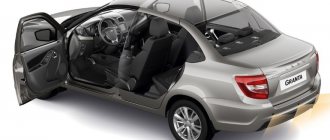Test drive of the exclusive Lada Granta Sport with 128 horsepower: this is not a sport, this is a fight
If only they would have made her a chain timing belt, it would have been more reliable and durable, but this would have eliminated the fairy tales about how valves and pistons meet when the timing belt breaks, etc. But then a larger number of buyers would be attracted by such a not so complicated change in the design of the car.
Tarantas is what you need; and the straight-lined silhouette and trunk in the liftback body are also conducive to all kinds of suburban and business travel..
If only they had not made such windows for this body - wider, but left them the same size as on the old Kalina - this and the appearance of the whole car would have been more decorative than these windows, which with a small radius of wheels and a very short body look so-so, like a car from cartoon =)
It’s unlikely that this same transformation (wider windows) actually significantly added visibility to the driver (?!), but there’s no point in getting to the bottom of it; What is stronger - an iron door panel or glass - which now turns out to be a little stronger than in the old Kalina?!
So it turns out that such a redistribution is both a waste of time and materials, but also a less attractive solution in the design of the car, and now the driver and passenger cannot place their hand on the end of the door because the edge of the door glass now sticks out there because that all the glass stupidly does not fit into the niche of the door... In my opinion, this is actually some kind of design crap (I apologize wildly).
If we repeat in order all the disadvantages of such a solution, then the “tactics of evolution” of the design of Lada cars emerges, a diagram in which you can clearly see how, through errors on the assembly line, the car receives new and new transformations, but those improvements could have been made on paper - without bringing it to conveyor, an unformed prototype, and without wasting any time or money or effort (!)
Of course, many will say that these are nit-picking, and that there are much more important technical aspects in the car, but for me personally, such “design decisions” are enough for me to want some kind of car or not to look in its direction even just because of how it looks. .
By the way, is it necessary to prove that approximately 50% of all buyers when buying a car, the first thing they consider is the attractiveness of the car’s appearance?
Well, if the buyer also sees behind that appearance the practical aspects formed by those very elegant lines and shapes, and understands that they correspond to common sense - then in 99% of cases such a car is purchased for a long time, if not forever, even with some obvious technical flaws.
Lada Granta Sport
Externally, the sport version of the “Granta” differs from a regular sedan not only in the red and white “Sport” inscription on the trunk lid, the car received new larger bumpers with a sporty relief, different thresholds, a small wing was placed on the trunk, and the wheels became 16-inch with rims , made in the form of many spokes. The exterior of the Sport version has become much more attractive compared to the base sedan.
In addition to the appearance, the interior of the car has also changed, for example, in the middle of the front panel there is a 7-inch display of a multimedia system with touch controls with the same functionality as the Kalina Sport car. The steering wheel and gear lever are trimmed in leather with red stitching in a sporty style. The front seats have also changed; they now have pronounced lateral support and are made of more pleasant materials.
The sport versions of Lada Granta cars are available in a luxury configuration, therefore, they already have a full power package - electric windows on all doors, heated not only the rear window, but also the windshield, as well as the rear-view mirrors. In addition, the package includes air conditioning, on-board computer, driver and front passenger airbags. All these delights are available for both Lada Granta sports cars, however, unlike the Drive Active package, which is cheaper, the Sport package boasts rain, light and parking sensors, as well as a multimedia system with a large 7-inch touch screen with navigation.
As a power unit, the sports version of the Grants is equipped with two different 16-valve 1.6-liter engines. In the Drive Active configuration, the engine power is 106 horsepower, and in the Sport configuration 114. Together with the engine, an exclusively manual 5-speed gearbox is installed. Although the sports civilian sports cars of the Grant family lag behind in terms of power the sports versions of the Kalina (in particular the Lada Kalina NFR), they are much cheaper. However, the maximum speed of the cars is 195 km/h with a 114-horsepower engine, and the acceleration time to “hundreds” is 9.5 seconds. At the same time, fuel consumption for the Sport version is 8.6 liters, and for the Drive Active version 6.7 liters per 100 kilometers in the combined cycle.
But not only the engine and appearance make the Granta Sport a sports car; changes also affected the suspension - the conventional suspension was replaced with a stiffer and lower sports-type suspension. The braking system has changed, the front disc brakes have become larger in diameter, and instead of the rear drums, discs have also been installed, but with a slightly smaller diameter.
Exclusive: tough test drive of Lada Granta Sport and detailed report from production
The Sports Car Authority (SCA) would have been closed anyway. 2-3 cars a year with unobvious successes at any significant international competitions are not worth the hundreds of thousands (or even millions) of dollars that VAZ annually “poured” into this Department. Vladislav Nezvankin, who led the USA from 2007 to 2009, honestly speaks about this.
Vlad, before officially joining VAZ, worked there unofficially - as the creator and head of the TorgMash company (later TMS), which became the de facto “court” sportsman of the plant. Let us recall, for example, the Lada Revolution monocup, held at the expense of VAZ, but technically “built” by the same TorgMash. The USA, against the backdrop of a more flexible and enterprising competitor, existed neither shaky nor weak. And when in 2005 the decision was made to refuse to participate in the WTCC (the cars had already been prepared!), the USA found itself in a completely ambiguous position: money comes from the plant, more than a hundred people receive salaries, they even do something - but at the end of the day everything several Kalina categories R1 and R2 over several years.
In 2009, Vlad invited Viktor Shapovalov as a partner, who used his own money to support the Lada Sport team and build cars based on the Priora for European Touring. Together they returned VAZ not only to the WTCC, but also created the Grant Cup as a means of promoting the new VAZ model. But it still turned out that TMS and Lada Sport cope with the tasks without the USA, which is left with only the manufacture of power frames and the repair of the few Kalinas previously made. And a pre-storm condition arose in the air again. So the USA most likely would have been closed or otherwise reorganized if Nezvankin had not come to Komarov with a proposal to make a sports version of Granta. Not a “pseudo”, as was the case with the Kalina Sport in the OPP, but a really more sports car than a production car. But at the same time it is completely “civilian” in purpose. Fortunately, Shapovalov and his engineers have prepared a whole bunch of proposals for “sporting” Grants, from gentle to completely extreme. One of the “extreme” ones was made specifically for Komarov (200 hp, turbo) - and this, I think, played an important role in his decision to agree with Nezvankin’s proposal.
In principle, this is the most logical path for the sports division of a large automobile plant: to produce not only units of customer “combat” cars, but also to work for the general market, producing “hot” versions of production models. But the structure of the USA was completely unsuitable for small-scale production. We had a workshop with an area of 2.5 thousand square meters. meters to clear away old equipment, make repairs and re-equip. Now it’s bright, clean and very quiet - everything is done by hand, without conveyors, robots or any other sources of noise. Unless the pneumatic impact wrench squeals from time to time, as if reminding you: you have come to production, not somewhere.
A few steps through the new plant
“Bare” painted bodies come from VAZ, which are stored right on the street for the time being.
Of course, this does not go in vain for them: in several cars I saw large puddles, a couple of centimeters deep, in the niches for the spare tires.
Everything would be fine, but this particular part of the “Grant” body is painted according to the residual principle (read: very poorly), in some places there is no paint at all, only a primer covers the metal. And soil, as you know, is a porous thing (which ensures high paint adhesion), which tends to swell and allow moisture to pass through its capillaries to the metal. Plus, the vibration-damping “patch” never fits perfectly to the body, and if water gets under it, that’s it, corrosion peeling becomes only a matter of time.
Okay, let's go back to the workshop, to the assembly line.
The bodies are placed on carts and rolled between posts, of which there are 28. A post is not one operation, but a whole complex, so the body spends quite a significant amount of time in one place. In principle, the assembly cycle repeats the authentic factory one, and most operations could be performed on the main conveyor belt, removing slightly under-assembled bodies from it and making changes already at the stage of installing the power unit and chassis. But this would contradict the very concept of Lada Sport (USA, after a series of renamings, received this name) as a full-fledged production.
“You have to understand,” Nezvankin never tired of telling me, “garage automobile construction has already existed here, there are a lot of them everywhere.” We have a completely different task: we want to create a normal, profitable business, and not sit on factory handouts. The more we do ourselves, the higher our added value; accordingly, by optimizing some processes for ourselves, we can produce greater profitability than the average for VAZ.
However, there was still an idea to take partially assembled bodies from VAZ. But the plant management refused to remove the so-called “first set” from the assembly line - they say this disrupts the entire production cycle.
Alexander Dubinkin, Deputy Director for Production, leads me between the cars, telling me along the way: here we install glass, here we lay harnesses, here we make sound insulation...
Among the factory vibration-damping “no-name” stickers there are clearly foreign pieces of Vibroplast. This, as it turned out, is one of several deviations from the factory technology. Granta Sport with a louder engine and a larger diameter exhaust barely passed GOST standards for external and internal noise, so the body had to be additionally damped in some places. In particular, the floor under the driver's feet, the rear fenders, the trunk floor and the roof. But why did they take the simplest rubber Vibroplast, and not the more effective bitumen material? The point is technological capabilities: bitumen requires good heating and rolling. And rubber material a la Guerlain just needs to be applied and you won’t be able to tear it off. And it molds better, which is important for a textured floor.
Now Grant Sport is being assembled in violation of its own technical processes: there are not enough people. There are currently 24 people working on the assembly, to be fair, another 30 people are needed (two for each post, as planned). Plus, the logistics for components are not well-established; something is always missing. Therefore, you have to skip some operations and return to them later. But in general, the logic remains the same: seats will never be installed in the cabin before electrical wiring. And one more digression: the doors are not removed from the body for subassembly; all their filling is placed “in weight”.
The first of the serious units to be mounted on the body is the steering mechanism. This is a standard “short” rail, an accessory of the Granta in the “luxury” configuration. With it, the steering wheel should make 3.1 turns, but on the Grant Sport, due to the larger diameter wheels (16 inches instead of 14), additional rack travel limiters have to be installed. The result is approximately 2.8 turns, but this does not add “sharpness” to the steering wheel, but only increases the turning radius. Alas, this is the price to pay for palliative design solutions.
Until the Granta received a set of steering improvements from Kalina-2 (more rigid mounting and recalibrated electric power steering). But they assure that by the end of the year all Grants (and therefore Granta Sport) will receive steering from Kalina.
The instrument panel comes completely disassembled; in the Lada Sport it is “stuffed with contents” and installed on a rigid steel cross member...
... and bolted to the body. Then they connect all the electronics, heater, air ducts... All panels are only in the top configuration, with a large display.
The speakers in the doors are absolutely shameful, ordinary Chinese coaxials with a diameter of 13 cm. This is the choice of VAZ itself.
It’s funny that in some commercial vehicles this acoustic misery is covered up with grills from the well-known Signat company - not high-end, but not from the last row.
The seats with beautiful red stitching and Lada Sport logos are supplied by Tolyatti AvtoVAZAgregat. These chairs are based on a standard frame, only the padding is different, with better lateral support. They installed exactly the same ones on Kalina Sport, only with more modest finishing.
The contractor receives the steering wheel and gearshift and handbrake levers, stylishly covered in leather.
After the interior and part of the engine compartment are assembled, the cars are transported onto four three-ton lifts. Fuel lines, remaining brake pipes, a gas tank, and heat shields are already being installed here.
Then they begin the mystery - installation of the original suspension elements. Disc brake mechanisms are hung on the “Grant” rear beam and the wheel offset is increased with special spacers; At the same time, the rear track increases by 20 mm, and the base of the car is lengthened by the same 20 mm, due to shifted mounts of the rear brackets and a change in the inclination of the front pillars. 1 degree is added to the camber of the rear wheels, that is, the total is an addition of 2 degrees (according to other sources, 2.5). Shock absorbers with the Lada Sport nameplate (and their supports) are made in Tolyatti by Asomi-Engineering, the original, slightly stiffer springs are made in Moscow. For some reason the manufacturer of the springs is not named, apparently this is a condition of an intercompany agreement.
The front brake discs are also original, with an increased diameter, fortunately, sixteen-inch wheels from the Togliatti company Slik allow this. Tires: Yokohama C.Drive 195/55R16 V88; Lada Sport has long-standing contacts and almost exclusive conditions with this Japanese company. With all this equipment, the Grant Sport beats the regular Grant by 4 meters of braking distance (from 100 km/h). And, of course, trajectory stability during braking improves.
The front castor, as already mentioned, has been increased to 2.5 degrees, which gives more information to the steering and has a positive effect on handling. In principle, this is a very gentle setting; some road BMWs have caster up to 8 degrees! But with all the positive properties of strongly inclined struts, there are also negative ones: when cornering, the camber of the wheels changes significantly, and the tires wear out more. However, at a “granta sport” 2.5-3 degrees, dynamic camber is unlikely to manifest itself, but the quality of feedback improves noticeably.
The pendants are assembled ahead of time, in a separate room. Only one person does it!
Nearby, another person is modifying the rear hubs - making a groove for the rear wheel rotor. This allows ABS, originally intended for drum brakes, to be used with discs.
After the suspensions, Grant Sport faces the most important operation - installation of the power unit. There are no special winches or separate lifts; everything is simpler: the car is lowered onto a motor standing on a trolley. Having more or less oriented the cart, the unit is mounted on supports, after which the car is raised again and the exhaust tract is installed.
Another post, also with a lift, is intended for installing fiberglass (and not polypropylene, as on Grant) bumpers, filling with all liquids and freon, and bleeding the brakes.
Next is the assembly and installation of the wheels, after which the car is removed from the lift, it drives along an improvised “comb” (right in the workshop), shaking, so to speak, the suspension.
Now you can adjust the wheel alignment and send the car to the last posts in this workshop - the brake tester and headlight adjustment.
At the very end, as usual, is the elimination of paintwork defects. There is no light tunnel here; everything is done with a combination of daylight and artificial lighting, right next to the large window. I asked Dubinkin how many chips and scratches appear during the production process.
“Not really,” he says, “mostly dents on the doors, and even those have become much smaller in recent days.” When we switch to a separate door assembly, this problem should go away altogether. More defects come from the factory itself; there were even bodies that fell and were restored. But now we are changing something in logistics, and there are fewer defects.
The finale of the whole action is the power stand, it is located in another room, where the cars are already moving under their own power.
Here, the engine characteristics are taken and the VSV (external speed characteristics) graph is printed on paper. This piece of paper is not given to clients; it goes into the archive, along with the entire control card of the car. At any time you can see what the car came out of production if anyone has any complaints.
At the stand, first of all, the absolute power indicator is obtained, which is 120 hp. In reality, this value can fluctuate within 2 hp. - not such a big spread.
Next to the engine stand there is a tooling area where, among other things, the exhaust system is made. “Banks” of main and additional mufflers come from suppliers. All that remains is to bend the pipes in the desired configuration and weld it all into a single unit.
The holy of holies is the engine modification area. In engines coming from VAZ, the cylinder heads are opened and the camshafts are changed to sports ones, with a higher cam (9.5 mm). Torque increases to 156 Nm and is realized at 4900 rpm. Of course, such changes entailed recalibration of the ECU - this work was carried out with the Itelma company.
In the gearbox, the main pair is changed from serial 3.7 to 4.3. The gear ratio is more “high-torque”, but this is compensated by changed valve timing and increased speed, so that the maximum speed, according to official information, has even increased - to 197 km/h. The entire gearbox and other elements of the gearbox remain “grant”. The gearbox itself, of course, is a cable one - at the very initial stage, several machines with a traction drive were assembled, but now the plant only equips Grant-Lux with KP 2180.
Yes, we must say about one more important change in the design of the Granta Sport: the intake air is now taken from a different point, not from the radiator, where it has time to heat up, but higher up, where it is cooler.
Test drive with the Master
The next morning, Boris Maslov, a famous VAZ racer, an international master of sports, comes to pick me up in Grant Sport! We have the car at our disposal for the whole day, we can go anywhere. We drive towards Samarskaya Luka - there are relatively good and very free roads there.
The car sparkles with a cool gloss, growls in response to throttling, and trembles in response to it, and noticeably. It is obvious that the natural frequency and amplitude of vibrations of the power unit have become different, and the standard supports clearly cannot cope with them. The vibrations are clearly transmitted to the controls, but, damn it, they don’t interfere at all; on the contrary, through this oscillatory connection a feeling of unity with the car is created! This is not a killer vibration stand, it is a good massage chair in which the “relaxation” mode has been removed, leaving only “moderate stimulation”.
I don’t know whether the new exhaust system underwent special acoustic tuning, but the sound in timbre came out quite “porky”. Maybe it has a little less pleasant overtones and even harmonics than the Porsche, the expressiveness, again, is weaker... However, I will not call this sound unpleasant, no. This is also a factor of stimulation, I didn’t get into a pensioner’s Granta, on the stern I have the Lada Sport nameplate sparkling with a cool gloss! Why not “growl”?
Immediately, at the first start, the peculiar (let's say) behavior of the car at low speeds catches your eye. It’s no longer easy to get going - there’s not enough traction in the usual rev range, and once you start, you immediately have to adjust your habit of switching to the next gear, focusing on the ratio of traction and engine voice. In the Grant Sport, the balance of these values is disrupted; in addition, the tachometer has also ceased to be an objective means of control, it is configured for a standard engine! And in Granta Sport the crankshaft spins at least 1000 rpm more. On the tachometer, the red zone starts at 5500 rpm, but in reality the “cut-off” is triggered at 6600-6700 rpm. Convincing traction is maintained almost to the very limit, up to 6000-6200 rpm.
The best acceleration is when you shift around six thousand rpm. And God forbid the needle drops below one and a half thousand, there is a dead zone, there the car will convulse and give out such a characteristic “rrrrrrrrrr” that it will discourage any desire to drive hard. Only revolutions! Only the latest possible switchings! Of course, this is inconvenient during smooth, leisurely driving. And the Granta Sport tolerates slow movements on sand and other weak-bearing soils, including wet grass, very poorly. You have to keep the engine in the normal thrust zone and constantly turn the clutch on and off, deliberately allowing it to slip deeply on the flywheel. So what to do? This is better than tearing off the wheels and immediately burying yourself in the sand, grass, or mud. It is clear that Shapovalov did not make an SUV from Granta... But as a universal summer car, Granta Sport is clearly not worth buying. I think that even in winter, in the absence of a traction control system, starting will not be very easy.
But it’s summer in our yard, sunshine, cool shine, everything’s going on. That's why we're going to a closed speedway to test the car's limits.
2.5 thousand revolutions, clutch “throw”. You will have to accept the fact that it will not close immediately; the force of a standard diaphragm spring is not designed for such starts. Second gear - up to 85 km/h, nothing else, the limiter is activated. Third - 115 km/h. That’s it, we’re going in fourth, it’s almost “straight”. But, choo! The limiter also worked in fourth gear, as soon as the car changed 170. If you need to go faster, you can’t avoid engaging fifth gear.
Yes, changing the main pair, increasing engine speed and shifting its “torque plateau” destroyed all the harmony of the standard Granta gearbox. The shift is partly compensated by an increase in the diameter of the wheels (at 16 inches, by the way, the speedometer almost doesn’t lie), but only partly. In a good way, all the gears need to be re-selected - this is the only way to realize the increased capabilities of the motor. And, probably, Granta Sport needs a six-speed gearbox. Not because the engine doesn’t like spinning up loudly – it just does, but only to reduce the noise level. At maximum speed, the engine howls so much that no Vibroplast, no matter how much you put on it, can handle it.
Subjectively, the dynamics feel very good; there is no doubt about the declared 9.5 seconds “to hundreds”. With skillful handling of the controls, this indicator can certainly be overcome. But the elasticity of the engine fell victim to its own sportiness. Acceleration in top gear in the range of 140-180 km/h makes you yawn: when will this end, huh? No, here you need to twist each and every gear to the limit! Having come to terms with noise and increased fuel consumption.
On the expressway, turn off the air conditioning and close the windows tightly. Damn, it’s hot - but why don’t you do it for the sake of science? — we even turn off the interior ventilation. That's it, not a single extra consumer, all the power goes to the car. 190... 195... 197... Well, little grant, well, dear, come on, there’s just a little left. 199... Yes: 200! I ask Maslov to turn on the ventilation, air conditioning and high beams - it’s stupid to let go of the steering wheel yourself at such a speed. However... Boris, wait, I can do it myself! No problems holding the car, it flies like a thread tied to the center of the road. There is absolutely no need to strain yourself in anticipation of trickery every second, as on a regular Grant. About fifty kilometers without letting off the gas, at the limit of capabilities - and no fatigue, no desire to slow down.
This is some kind of magic: with such simple means as a slightly (yes, slightly!) increased inclination of the front struts and different wheels, you can completely rid the car of slurred steering! From yaw at high speed, from complete emptiness on the steering wheel in the near-zero zone... We need to tell Grunenkov, the director of the Grant/Kalin projects, maybe he doesn’t know this recipe? (Here, of course, there is a smiley face: everyone at VAZ knows about Granta).
So, we turn on the air conditioner and other consumers - and watch how the speed drops right before our eyes. 195... 193... 183 km/h! This is in the same area where we just reached the “maximum speed”. That's it, you can't squeeze more out of the car.
We return to more or less normal speeds. I wonder how the practically new suspension affected the car’s handling?
Here's how: everything that Grant had had to be divided into two. Tendency to swing? Reduced by half. Rolls? Also half or a little less. The moment the front wheels come off? Of course, not a twofold increase in speed, but noticeable. The feeling is that once the car was set up correctly. Then they tried to remove the matrix from it for duplication, but the copyist’s hand trembled and the tracing paper moved to the side. Don't be a fool, he didn't tell anyone about the mistake - and they started printing the wrong copy. This is the Lada Granta.
And then another person came, took blank paper - and pedantically, stroke by stroke, transferred the original image into a new matrix. This is Granta Sport. This is exactly how the basic Grant should be in terms of controllability. To hell with it, with reduced suspension travel and a little more rigidity, this is unprincipled. I deliberately drove quite a few kilometers along various country roads and even across an open field: if you do not run into very treacherous holes, the suspension handles the unevenness quite smoothly. There is no expected grinding, no all-consuming shaking. Normal energy intensity, no worse than some Focus or Octavia. And this is on fairly low-profile tires, don't forget.
In long corners with sliding (more precisely, on the verge of sliding), the tires determine the handling. And I have to share the choice of the creators of Grant Sport! On C.Drive, the car is expertly controlled with gas in turns, the feel of the front wheels is close to one hundred percent. There are probably more grippy tires, there definitely are. But personally, what’s more important to me is not the maximum speed in a turn without stalling, but the car’s obedience when going into a slide, albeit at a lower speed. There is less pure sport with its pursuit of milliseconds. But what a thrill!
One day I overestimated both my and the machine’s capabilities, flying into a 90-degree turn with a clear excess. Of course, it was at that moment that an old “nine” appeared in the oncoming lane. There was absolutely no time to think about tactics, everything happened automatically: releasing the gas, turning the wheels completely against the drift, immediately straightening them - and full throttle, diagonally from the “nine”. Yokohama instantly found a hold - and we separated from the “nine” in a matter of centimeters. Ashamed? Of course, it’s a shame, especially if an international-class sports master is sitting to your right. But Maslov didn’t even raise an eyebrow, not to mention any notations. I just asked teasingly: do you want to star in the film “Taxi-5”?
There is a lot of excitement about Granta Sport, it’s even embarrassing. Probably, for the sake of balance, it’s worth mentioning the significantly increased turning radius, by at least 15 percent. Where you can turn around on Granta in one step, Granta Sport will require at least two. And another obvious problem was discovered: after two or three hours of intensive use, the idle speed becomes unstable. It is enough to simply release the gas pedal, no matter whether it is in neutral or in gear, and you begin to feel a nasty twitching. The revolutions are trying to fall below the minimum, the ECU disciplinedly throws them up - and St. Vitus’s dance begins: either an attempt to stall, or automatic acceleration. There is no such thing under thrust, only at XX. But it's still unpleasant. Moreover, since the defect is floating, we were unable to simulate clear conditions for its manifestation. One thing is obvious: this only happens on a hot car, at a temperature close to critical.
Granta Sport as a business project
Let's generalize. Did Granta Sport turn out to be more interesting than Granta? Without any doubt. Did it turn out more harmonious? No and no again. Shapovalov and Co. did upset the Grant balance, the fragile balance of all the consumer properties of the car. Acoustic comfort “floated away”, shaking in the rear seats became on the verge of decency, at low speeds the car “does not move”... And now the final question: did the creators of Grants Sport hit the target determined by themselves? Certainly! Right on the bull's eye, one hundred points out of one hundred. To achieve such an expressive result with such a small amount of alterations is not only a matter of talent, but also luck. Granta Sport turned out to be an unimproved Granta, an unfinished conveyor machine - it became itself. A separate model with a specific set of advantages and disadvantages and an equally specific consumer.
Will Lada Sport succeed in business with this model, will it turn out that 9 months of work and $1 million of investment will become the price for another failed experiment? Let's see. So far, everything is going well: at a price of 438,000 rubles, the Granta Sport is almost equal to the Granta “automatically” in the “luxury” configuration. The new Kalina will be even more expensive with similar equipment. So Lada Sport has a very balanced pricing policy, despite the fact that their profit margin is higher than that of VAZ - 10-12% versus the average VAZ 7%.
The business plan is designed for five years, but within three years Lada Sport should reach the break-even point and begin to generate profits. This will happen with a production volume of 5000 pieces. This year they plan to make a thousand cars, and next year - 2.5 thousand. All investments should pay off in four years.
I visited Lada Sport in mid-May, at that time 50 commercial vehicles were shipped, and a total of 83 were made. This is from February 27, actually a month of work (taking into account the May holidays). They want to finish June with 100 cars.
I also visited a specialized Lada Sport car dealership. This, let me tell you, is something: an absolutely “proprietary” approach to everything, from design to the style of communication with clients and forms of invitation to a test drive. It doesn't even smell like Zhiguli there.
And, of course, the sports theme is used very competently: in the salon there is a Cup Grant, like an enticement.
A separate cabinet is dedicated to branding and accessories with the Lada Sport logo.
Brand building in action. And you know who fell for it? Do you know who was one of the first buyers of Granta Sport? Sergey Medinets, project manager for Grant at VAZ! I completely accidentally ran into him at the Scientific and Technical Center and couldn’t help but ask about Shapovalov-Nezvankin’s car. And not only did he admit to the purchase, he said: he paid 443,000 rubles, no discounts.
Businessmen, what should we take from them...










